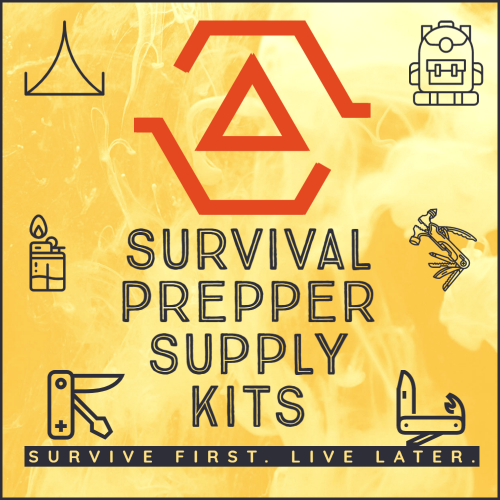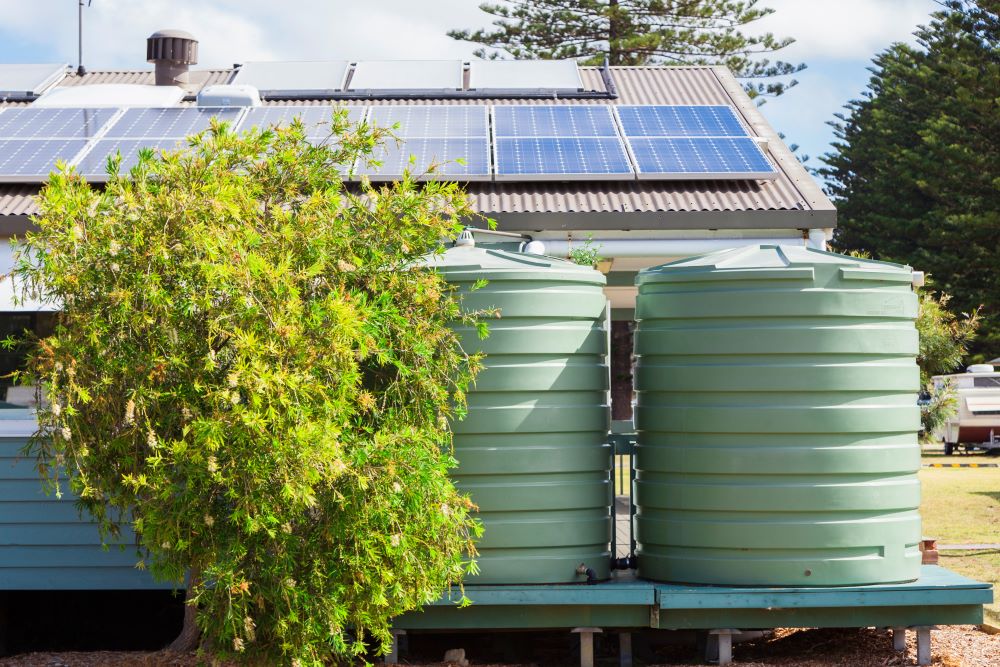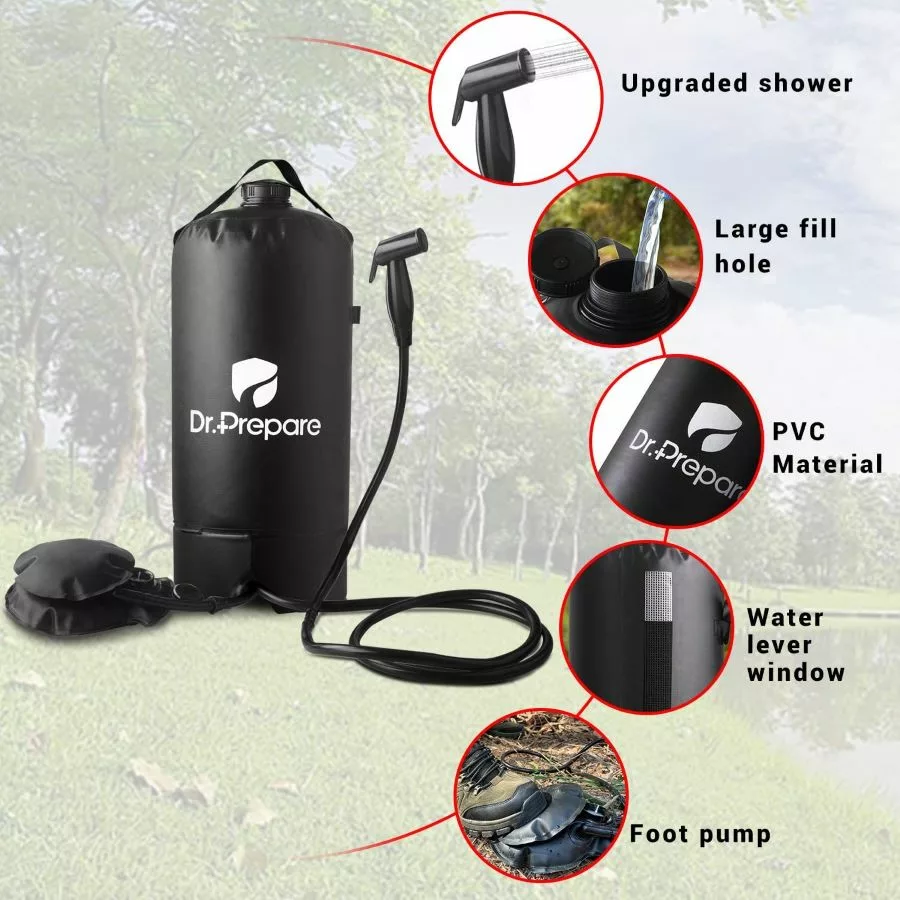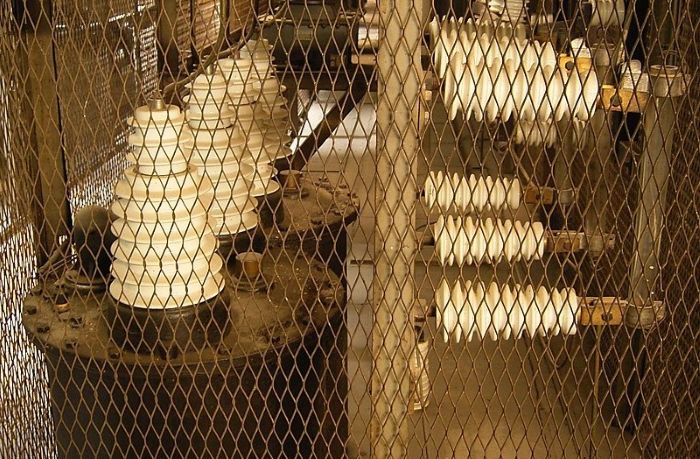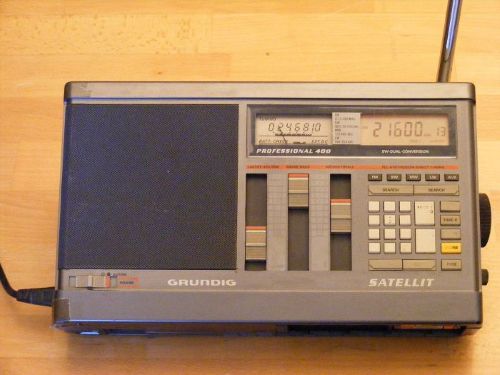Water storage is the most important thing to consider regarding survival preparation. One of our most valuable natural resources is water. However, most of the water that falls during a rainstorm is collected in storm drain systems and must be treated before being recycled. However, it is possible to design systems that allow you to collect and use rainwater where it most benefits you. Following a plan for your household’s use of rainwater can save money and natural resources.

The Advantages of Using and Storing Rainwater
Rainwater collection and use have numerous benefits. You gain from it, and so does the environment around you. This is not a novel concept; people have long stored rainwater. As we’ve learned how beneficial it can be, its popularity has only increased recently. You can decide to start using rainwater after learning more about these advantages. Use the below for showering using your stored rainwater!
Dr. Prepare 4-Gallon Portable Camp Shower is back with upgraded design to bring outdoor shower to a next level. Whether you are planning the annual family camping trip, or searching for a mobile water source for cleaning job in the yard, this all-new camp shower bag is sure to be a helpful hand to hit your goals for cleaning.
Place the solar shower bag in direct sunlight to heat up water for a soothing hot baths.
- Upgraded Screw-On Lid make it easier to open and close.
- The water level window on the side of the outdoor shower reveals real-time water amount.
Key Features
- 【Upgraded Screw Cap】The long-awaited threaded lid is finally available on this latest portable camp shower in response to customer feedback. Fill water via the enlarged inlet, hand-tighten the cap to ensure closure, and you are good to go.
- 【Hands-Free Spray Nozzle】Fix the nozzle on high and flip up the versatile trigger in the spray position to deliver a continuous flow of water, so you can take time to cleanse your hair or wash dishes.
- 【Efficient Foot Pump】Step on the foot pump to get the high-volume shower bag pressurized for a quick rinse when you are away from home. Thanks to the updated check valve, water will not flow back to the pump.
- 【Water Level Window】No more guesswork. The clear window on the water bladder allows you to keep track on real-time volume. Now made up with all-new meshed fabric for enhanced build quality and leak-proof performance.
- 【Pack and Go】Pack down this travel-friendly shower with its nozzle, hose, and foot pump well to the zippered storage bag when you are camping, hiking, backpacking, and trekking in the wild. Perfect for rinsing off sands on feet, bathing muddy pets, or washing spotted cars as well.
- First, keeping rainwater on-site prevents erosion and flooding that your gutters’ downspouts might otherwise cause. By doing so, you can maintain the attractiveness of your yard and keep water from entering storage drain systems.
- Saving money is another benefit of collecting and using rainwater. Water used to wash your car or irrigate your lawn is typically a consumable that requires payment. On the other hand, if you save rainwater, you can use it for nothing.
- Using rainwater to water your plants will give them better nutrition. Naturally occurring minerals in rainwater are beneficial to plants. Additionally, it is free of the contaminants and chemicals found in regular tap water.
- If you live in a region susceptible to drought, collecting rainwater now can give you access to water later. While there may be restrictions on city water use during a drought, you will still have access to your rain barrels.
- In terms of the environment, fresh water is a very scarce resource. Water that can be used for drinking and other domestic purposes makes up just 3% of the total water supply in the world.

Establishing a Rainwater Storage System
In recent years, catching rainwater has gained popularity as a water-saving technique. That’s good news because it has made it possible to find a variety of storage systems. Utilizing a rain barrel is one of the most preferred and affordable strategies. The water from your home’s gutters can be collected in large rain barrels. Large trash cans or buckets can be used to make them.
Natural water sources in industrialized nations are drying up due to high water consumption. Collecting rainwater can conserve a renewable resource and keep contaminated water out of storm drainage systems. Additionally, you can buy ready-to-assemble commercial kits made specifically for storing rainwater. Once you’ve established a system, your bucket will fill each time it rains.

It’s crucial to take safety precautions when using a rain barrel. For instance, the top needs to be pet- and child-proof so that small children and pets can’t fall in.
You should also have a filter at the top to keep debris from entering the barrel with the rainwater. If you discover that this system is effective for you, you can add more barrels to ensure no overflow during the rainy season.
Most rain barrels have a tap at the bottom to drain the water. Some of them let you connect a typical garden hose so you can use the water in your yard.
Always ensure that the materials you use to construct your rain barrel are of food-grade quality. The water will be safe because it won’t leach dangerous chemicals into the water.
While rain barrels are the least expensive and easiest to install, more sophisticated systems are available if you want more water storage and can afford the higher cost.
A rain barrel typically has a capacity of 50 gallons. To hold more water, you can have more than one barrel. But you’ll need a different collection system to store a lot more. The Rainwater Pillow is one option.
The Rainwater Pillow system uses a fabric container to hold 1,000 gallons or more of water. Depending on the size you choose, it will hold a certain amount. The original 1,000-gallon capacity is adequate for the average homeowner. This system is much more expensive, costing thousands of dollars, but it might be a wise investment if you use a lot of water in your home for farming or gardening.
Alternatively, you could spend money on an underground system that collects rainwater and enables you to pump it out for use. You can buy a system that can be used to flush toilets and supply water for your lawn and garden. Due to its size, underground location, and materials, this system is considerably more expensive than alternative solutions. However, reducing your reliance on other water sources can eventually pay for itself.
You should search in your neighborhood for a business that specializes in this kind of system if you want to have one. Your area’s cost and your particular requirements will vary.
For the Cleanest Water, Use First Flush Systems
One worry that people have when using a rainwater barrel system from the rooftop is that as the rainwater travels to the gutters, it may become contaminated by materials on your rooftop.
- FIRST FLUSH: Protect the integrity of your rainwater by diverting initial runoff through the first flush diverter to ensure only the highest quality water is captured.
- AUTO DRAINING: This first flush diverter features a slow-release valve that automatically drains the chamber while in use, keeping it ready for the next rainfall.
- JUST ADD PIPE: The First Flush with Catch All Tee includes everything you need to install a 3" pipe for the chamber.
- CUSTOMIZE YOUR DIVERSION VOLUME: The system is easily customized by adding the length of pipe to suit your first flush requirements.
The first flush of water from the roof can contain significant amounts of contaminants, sediments, and residues. Instead of flowing to the water tank, these pollutants are diverted with the initial water flow into the chamber of the water diverter. The water diverters from Rain Harvesting utilize a dependable ball and seat system – a simple automatic system that does not rely on mechanical parts or manual intervention.
The water in your barrel could become contaminated, which is a serious concern. Utilizing a first flush system is a fantastic remedy for this. As the first rain washes away debris, it is typically the most polluted.
The first five or even 10 gallons of water are stored and separated from the remaining rain barrel storage with a first flush system. This water is the one that is most likely to contain chemicals or sediment.
Use that water for your lawn, and then use the remaining water for your needs, such as a vegetable garden or house cleaning.
Rain Barrel Upkeep
Once you have a rain barrel, you’ll need to take care of a few things to keep it in working order so you can use the water you’ve saved. You can maximize your system’s potential by following these easy steps.
At least once per month, you should empty your barrel so that algae don’t grow and the water doesn’t get musty. You can add a capful of chlorine bleach to the barrel to allow water to sit longer. This will prevent algae growth; at that low concentration, it won’t harm your plants. If you use it more frequently than that, it might become harmful. Because vinegar contains an acid that will harm your plants, you should also avoid using it.
You should clean your gutters frequently or install a gutter screen that keeps debris out if you have gutters. This will lessen the sediment and debris entering your rain barrel.
You don’t have to discard your barrel if you discover a leak. The hole can often be sealed using aquarium caulk made of silicone. This is inexpensive and accessible in hardware stores.
The growth of mosquito populations is another issue with rainwater barrels. One method to avoid this is to drain the barrel regularly. However, you can also include a larvae tablet in your barrel to stop mosquitoes from reproducing. By including this kind of tablet, you won’t harm your plants and avoid issues like the West Nile virus, which is spread by contact with mosquitoes.
If you reside in a region with extremely cold winters, you should take extra precautions. Your rain barrel may become weak if it is repeatedly frozen and thawed. Draining your barrel and disconnecting it will help you avoid issues before it gets that cold.
It is best to store your rain barrels upside down when storing them for an extended period. Thus, any debris is kept off of them.
How Much Rainwater Can You Collect?
You might believe your rain barrel will take a while to fill with water. But you can gather a lot of water—hundreds of gallons annually. You can calculate the approximate amount of water you’ll collect for every inch of rainfall.
- The square footage of your roof needs to be estimated first.
- Then, divide that result in half.
- The final figure represents the volume of water that can be stored from a single inch of precipitation.
The typical home can hold more than 400 gallons of water with a half inch of rain. That adds up quickly during rainy seasons, as you might imagine. Having multiple barrels or bigger systems is a great idea for this.
Applications for Rainwater Storing
- Rainwater is typically not used for drinking, although it can be done. You might be surprised to learn how many different ways to use rainwater that has been stored.
- The most obvious application is watering your lawn and garden with the rainwater you collected. Watering your lawn in the hot, dry summer months can get expensive. You can get free water by using a rainwater collection system.
- Additionally, it will enable you to keep watering even if your water service has put restrictions in place due to drought. Using your barrel with a soaker hose is among the simplest methods. It can be used to maintain the irrigation system for your lawn and even to safeguard the home’s foundation.
- Many cities allow residents to flush toilets with rainwater, though this isn’t an option everywhere. You could even install a rainwater system to bring water into your house to flush the toilets automatically. Having a large family or numerous frequently used toilets can save you significant money on your water bill.
- If you have a car, you can fill the radiator with rainwater rather than tap water. Most often, this needs to be combined with antifreeze. You could wash your car with rainwater. In addition to saving money, you will be conserving water.
- You can mop with rainwater instead of tap water when cleaning your house. To clean your floors and other surfaces, fill a bucket and bring it inside.
- If you have a filter system to make the rainwater suitable for indoor use, you can use it to wash dishes and even take baths. Laundry can be done with it as well. Since a significant portion of household water use is used for laundry, this can result in significant financial savings.
- If a natural disaster or other emergency prevents you from using your regular water supply, storing water in rain barrels can be helpful. Before using it, ensure you have the necessary filtration and purification equipment. For instance, you might have to boil the water before drinking it or add water purification tablets.
- If you have more water than you can use, you can even share it with your neighbors. This can serve as a wonderful illustration and inspire other people to set up their own rain barrel systems.
Your little rain barrel system might not seem like it would make much of a difference to you, but it could.
Do you have any tips on using rainwater? Leave me a comment below with these tips or questions you might have. Maybe you can help others, too!
